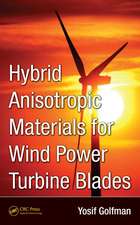Non-Smooth Thermomechanics
Autor Michel Fremonden Limba Engleză Hardback – 9 oct 2001
| Toate formatele și edițiile | Preț | Express |
|---|---|---|
| Paperback (1) | 650.37 lei 6-8 săpt. | |
| Springer Berlin, Heidelberg – dec 2010 | 650.37 lei 6-8 săpt. | |
| Hardback (1) | 656.74 lei 6-8 săpt. | |
| Springer Berlin, Heidelberg – 9 oct 2001 | 656.74 lei 6-8 săpt. |
Preț: 656.74 lei
Preț vechi: 772.64 lei
-15% Nou
Puncte Express: 985
Preț estimativ în valută:
125.68€ • 131.05$ • 104.45£
125.68€ • 131.05$ • 104.45£
Carte tipărită la comandă
Livrare economică 20 martie-03 aprilie
Preluare comenzi: 021 569.72.76
Specificații
ISBN-13: 9783540665007
ISBN-10: 3540665005
Pagini: 500
Ilustrații: XVI, 480 p.
Dimensiuni: 155 x 235 x 22 mm
Greutate: 0.87 kg
Ediția:2002
Editura: Springer Berlin, Heidelberg
Colecția Springer
Locul publicării:Berlin, Heidelberg, Germany
ISBN-10: 3540665005
Pagini: 500
Ilustrații: XVI, 480 p.
Dimensiuni: 155 x 235 x 22 mm
Greutate: 0.87 kg
Ediția:2002
Editura: Springer Berlin, Heidelberg
Colecția Springer
Locul publicării:Berlin, Heidelberg, Germany
Public țintă
ResearchCuprins
1. The Description of a Material.- 3. The Constitutive Laws. Case of No Constraint on the State Quantities or Their Velocities.- 5. The Constitutive Laws on a Discontinuity Surface.- 6. Deformable Solids with Interactions at a Distance.- 7. Deformable Solids Without Interaction at a Distance.- 8. Collision of Rigid Bodies. Multiple Collisions.- 9. Evolution of Two Deformable Solids with Collisions.- 10. Material with Volume Interactions at a Distance. Fibre Reinforced Material.- 11. Solid—Liquid Phase Change. Supercooling. Soil Freezing.- 12. Damage. Gradient of Damage.- 13. Shape Memory Alloys.- 14. Unilateral Contact. Contact with Adhesion.- A.1 Convex Functions.- A.1.1 Subgradient of a Convex Function. Subdifferential Set.- A.1.2 Indicator Function of a Set.- A.1.5 Indicator Function of the Segment [0, 1].- A.1.7 Indicator Function of a Triangle.- A.1.9 A Property of the Subdifferential Set.- A.1.10The Dual Function of a Convex Function.- A.2 Material Derivatives.- A.2.1 Material Derivative of a Function.- A.2.2 Material Derivative of a Surface Integral.- A.2.3 Material Derivative of a Double Surface Integral.- A.2.4 Mass Balance on a Surface.- A.2.5 Material Derivatives of Integrals of Mass Densities.- References.
Recenzii
"This book offers a fresh point of view and a new unifying approach to several different phenomena involving complex materials in continuum mechanics." (Mathematical Reviews 2003g)
"Providing an introduction to non-smooth thermodynamics and its application to a number of practical problems in mechanics, civil and mechanical engineering, this book appeals to both students (at a graduate level) and researchers." (Zentralblatt MATH, 990/15, 2002)
"Providing an introduction to non-smooth thermodynamics and its application to a number of practical problems in mechanics, civil and mechanical engineering, this book appeals to both students (at a graduate level) and researchers." (Zentralblatt MATH, 990/15, 2002)
Textul de pe ultima copertă
Based on practical problems in mechanical engineering, the author develops in this book the fundamental concepts of non-smooth thermomechanics and introduces the necessary background material needed to deal with mechanics involving discontinuities and non-smooth constraints. From this point, powerful methods for the applied mathematician and the mechanical engineer are derived, and applied to numerous cases including collisions of deformable and non-deformable solids, shape memory alloys, damage of materials, soil freezing, supercooling and solid--liquid phase changes, to name but a few. This book will be of great value to both the researcher and practitioner, but it can also be used as an advanced text for students in civil and mechanical engineering.
Caracteristici
The authors presents in book form for the first time the method he has developed himself Many illustrations come from his own laboratory












